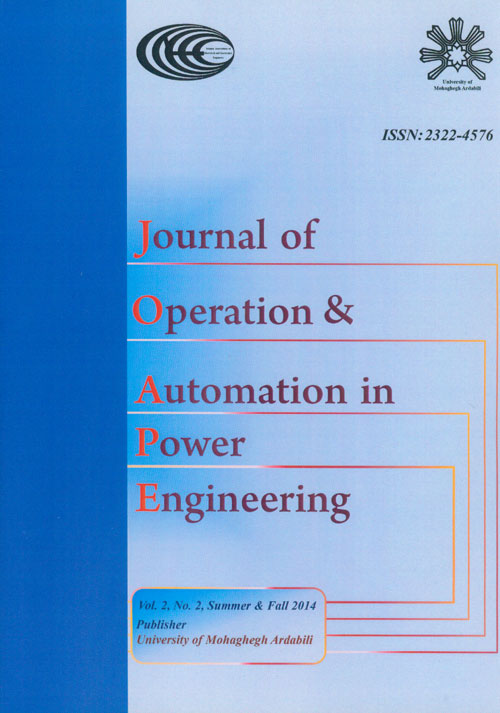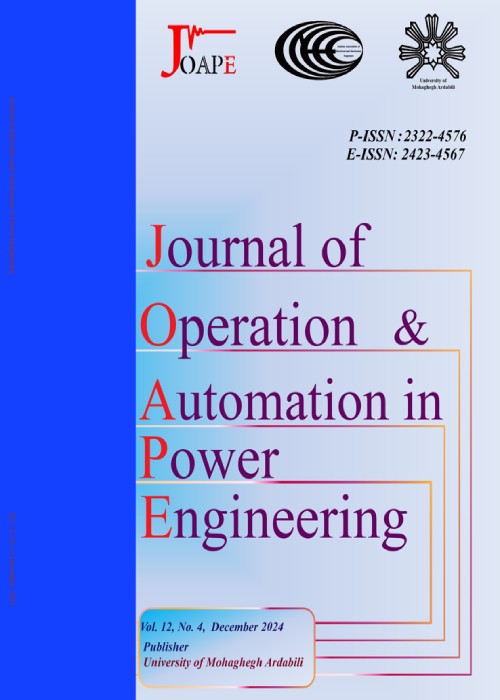فهرست مطالب

Journal of Operation and Automation in Power Engineering
Volume:2 Issue: 2, Summer - Autumn 2014
- تاریخ انتشار: 1393/09/27
- تعداد عناوین: 7
-
-
Pages 81-90In this paper, a new cascaded multilevel inverter by capability of increasing the number of output voltage levels with reduced number of power switches is proposed. The proposed topology consists of series connected of a number of proposed basic multilevel units. In order to generate all voltage levels at the output, five different algorithms to determine the magnitude of the dc voltage sources are proposed. The reduction of the used power switches and the variety of the value of the dc voltage sources are two main advantages of the proposed topology. These results are obtained by comparison of the proposed inverter with the H-bridge cascaded multilevel inverter. The remarkable ability of the propsed topology with its algorithms in generation all voltage levels (even and odd) is verified thruogh PSCAD/EMTDC simulation and experimental results of a 17-level inverter.
-
Pages 91-102This paper presents a new hybrid method for optimal multi-objective reconfiguration in addition to determining the optimal size and location of multiple-Distributed Generation (DG) in a distribution feeder. The purposes of this research are mitigation of losses, improving the voltage profile and equalizing the feeder load balancing in power distribution systems. To reduce the search space, the Improved Analytical (IA) method has been employed to select the optimum candidate locations for multiple-DGs, and the Intelligent Water Drops (IWD) approach as a novel Swarm Intelligence (SI) based algorithmis used to simultaneously reconfigure and identify the optimal capacity for installation of DG units in the distribution network. In order to facilitate the algorithm for multi-objective search ability, the optimization problem is formulated for minimizing fuzzy performance indices. The proposed method is validated using the IEEE 33 bus test system at nominal load. The obtained results prove this combined technique is more accurate and has an efficient convergence property compared to other intelligent search algorithms. Also, the obtained results leadto the conclusion that multi-objective simultaneous placement of DGs along with reconfiguration can be more beneficial than separate single-objective optimization.
-
Pages 103-112This paper presents a comparative analysis between two current control strategies, constant source power and generalized Fryze current, used in active power filter (APF) applications having three different modulation methods. The hysteresis band (HB) and first-order Delta-Sigma modulation (DSM) as well as the second-order DSM is applied. The study has been applied to a three-phase system with different rectifier as a load of power system. The power section of the active power filter is viewed as an analogue to digital converter (ADC), then as a result a three-phase shunt active filter modulator controller which uses Delta-Sigma analogue to digital converter is presented to improve modulator performance. Simulation results show that by using the first and second order Delta-Sigma control strategies, total harmonic distortion (THD) can be significantly decreased. Moreover, active filter based on the second-order DSM with constant source power has better performance and provides lower source current THD.
-
Pages 113-120The microgrid concept provides attractive solutions for reliability enhancement of power distribution systems. Normally, microgrids contain renewable-energy-based distributed generation (DG) units, which their output power varies withdifferent environmental conditions. In addition, load demand usually changes with factors such as hourly and seasonal customer activities. Hence,these issueshave to be consideredin evaluating the reliability of such a power distribution systems. This paper evaluates the reliability performance of distribution systems with uncertainties in both generation and load demands. The results of applying the proposed approach to a case study system verify its advantages compared to the previous studies.
-
Pages 121-128This research work presents 3D FEM analysis and experimental test of an air-cored axial flux permanent magnetic synchronous generator for low speed, direct drive applications. The structure consists of double rotor and coreless stator. The presented topology results in the absence of core losses, reduction of stator weight and elimination of cogging torque. The flux leakage is reduced with proper rotor design of the proposed structure. In addition, the generator output voltage is improved and it becomes nearly sinusoidal waveform. The generator performance is confirmed by implementation analytical and three-dimensional finite-element numerical methods. The simulations results of the proposed generator coincide very well with the experimental results on a prototype system realized in the laboratory.
-
Pages 129-140Optimal Reactive Power Dispatch (ORPD) is an effective solution to overcome voltage stability issues in power systems. In this paper a multi-objective optimization technique for this problem is employed using Static VAR Compensators (SVC) placement and Seeker Optimization Algorithm (SOA). Considering control variables including excitation settings of generators, tap positions of tap changing transformers, sizes of fixed capacitors and voltages with locations of SVCs in the network, ORPD is obtained. The objective function includes minimization of active power loss, voltage profile improvement and voltage stability margin enhancement. Simulation results on IEEE 14 and 57-bus test systems, applying Genetic Algorithm (GA), Particle Swarm Optimization (PSO) and SOA, the efficiency of SOA in ORD is verified.
-
Pages 141-150Use of an electric differential (ED) in electric vehicle has many advantages. Despite its long reported success and possible advantages in terms of flexibility and direct torque control of the wheels during cornering and risky manoeuvres, the ED has several problems that have limited its applicability, for instance, an increment of control loops and an increase of computational effort. In this paper, an electric differential for an electric vehicle with four independent driven motors is proposed. The proposed ED is easy-to-implement and hasn’t the problems of previous EDs. This ED has been developed for four wheels steering vehicles. The synchronization action is achieved by using an Improved Fictitious Master technique, and the Ackerman principle is used to compute an adaptive desired wheel speed. The proposed ED is simulated and the operation of system is studied. The simulation results show that ED ensures both reliability and good path tracking.


